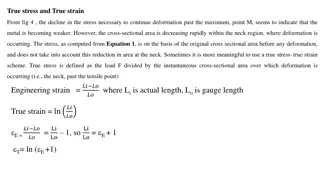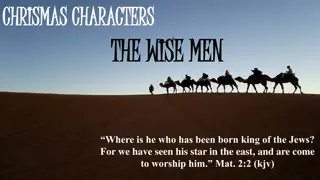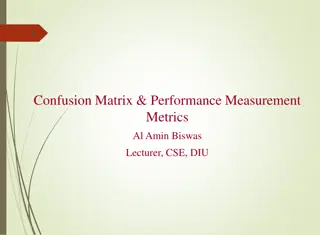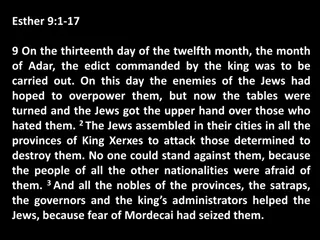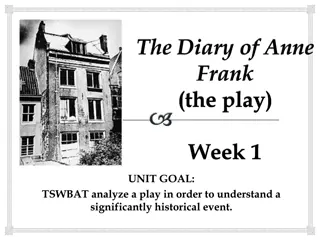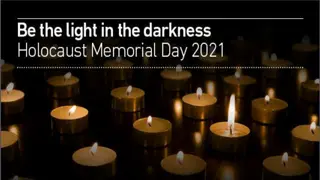Remembering the True Story of Oskar Schindler and the Jews of Krakow
A profound look into the heroic deeds of Oskar Schindler, a Sudeten-German industrialist who saved the lives of 1,200 Jews during World War II by employing them in his factories in Krakow, Poland. The film "Schindler's List" portrays his selfless actions, his sacrifices, and his place in history as a Righteous Gentile honored by the Holocaust Museum in Israel. Explore the historical background of Krakow, once a thriving center of Jewish culture, and witness the remnants of the past in today's Krakow, where Jewish sites still stand. The timeline provides a glimpse into the tragic events that unfolded in Krakow under Nazi occupation, highlighting the resilience of the Krakovian Jews.
Download Presentation

Please find below an Image/Link to download the presentation.
The content on the website is provided AS IS for your information and personal use only. It may not be sold, licensed, or shared on other websites without obtaining consent from the author.If you encounter any issues during the download, it is possible that the publisher has removed the file from their server.
You are allowed to download the files provided on this website for personal or commercial use, subject to the condition that they are used lawfully. All files are the property of their respective owners.
The content on the website is provided AS IS for your information and personal use only. It may not be sold, licensed, or shared on other websites without obtaining consent from the author.
E N D
Presentation Transcript
SCHINDLERS LIST A film based on the true story of Oskar Schindler, a Sudeten-German industrialist who moved east to Krakow, Poland at the outbreak of World War II Moved to Krakow to seek his fortune Saved the lives of 1,200 Jews by employing them in his factories
SCHINDLER COULD NOT IGNORE WHAT HE SAW. The film follows him as he rises above his love of money to risk his own life and possessions, eventually losing his fortune, as he secretly works to save the lives of his Jewish factory workers, the names of whom appear on Schindler s List
RIGHTEOUS GENTILES Schindler is recognized as a Righteous Gentile Moral non-Jewish people Honored by the national Holocaust Museum in Israel
HISTORICAL BACKGROUND Krakow was at one time the political and cultural center of Poland Is known to have a thriving Jewish population (since 13thcentury) In the 1930 s, Krakow s 60,000 Jews made up 25% of its population 3,000 Krakovian Jews survived the war Today, between 500 and 1,000 Jews live in Krakow (average age is 75)
TODAY In Krakow, many of the Jewish sites from the 14th century, the Old Synagogue, and parts of the 1941 ghetto wall still remain.
A BRIEF TIMELINE
1939 On Sept. 6, 1939, the Nazis occupied Krakow. Persecution of the 60,000 Jews began shortly thereafter. On Oct. 26, Krakow became the capital of the Generalgouvernment On Nov. 28, a Jewish Council (Judenrat) was officially established to carry out Nazi orders On Dec. 5 & 6, the Germans terrorized Jewish quarters and burned down a number of synagogues.
1940 In May 1940, Jews began to be driven out of Krakow. The forced labor camp at Plaszow was established on the site of two Jewish cemeteries in late 1940.
1941: GHETTOS By March 1941, more than 40,000 Jews were forced to leave Krakow. All of their property was taken from them. Those who remained were forced to live in a special part of the city called a ghetto By late 1941, 18,000 Jews, including thousands from nearby cities, were forced into the ghetto
1942 The sending of people from the ghetto to Auschwitz- Birkenau and Belzec execution camps started in May
1943 Jews who worked as slave labor in factories in and out of the ghetto were sent to Plaszow (in a subarb of Krakow). Although the number of prisoners varied, by the end of 1943, there were 12,000 prisoners at the camp. Amon Goeth, one of the five men who served as camp commander, held this position from February 1943 to September 1944
1944 In January, Plaszow became a concentration camp, and 600 SS men replaced the Ukrainian guards. During May and June, the number of prisoners at Plaszow increased to between 22,000 and 24,000. A total of 150,000 prisoners passed through the camp. 80,000 were killed there.
1944 As the Soviet Army neared Plaszow during the summer of 1944, the Nazis attempted to remove all traces of their crimes by digging up the mass graves and burning the bodies. Most of the prisoners remaining were sent to other concentration camps or execution camps (as happens to Elie and his father in Night).
1945 The last prisoners in Plaszow were sent to Auschwitz- Birkenau on January 14, 1945.
NOTES ABOUT THE FILM This film is based on fact. During the Holocaust, the slaughter of the Jews by the Nazis, Jewish people lived with the knowledge that they could be murdered simply because they were Jews. No excuse was needed for them to be killed.
However, Jewish people did need an excuse to be allowed to live. One way was to be classified as an essential worker, which meant that your trade or skills were essential to the German war effort. Thus, being essential workers kept Schindler s Jews alive initially. Schindler s cleverness and skill saved them later.
INFORMATION TAKEN FROM: Schindler s List: A Viewer s Guide from the Martyrs Memorial and Museum of the Holocaust of the Jewish Federation, Los Angeles, CA Sponsor Agency: American Federation of Teachers, Washington, D.C. Published in 1994
DONT CONFUSE THESE MEN IN THE FILM! Oskar Schindler Amon Goeth
As you are watching this film, please maintain an attitude of maturity and respect. After all, this event really happened. You will see images that hopefully make you feel uncomfortable; deal with them in a manner fitting of mature 16- and 17-year-old students. I hope I don t see anything inappropriate on your part, but if you can t handle watching this film, you will be given something else to do outside of the classroom.





